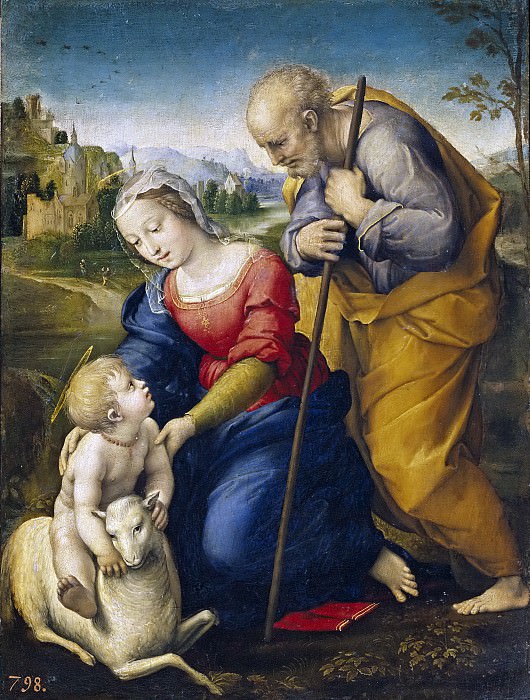Rafael – Sagrada Familia del Cordero Part 1 Prado museum
Part 1 Prado museum – Rafael -- Sagrada Familia del Cordero
Edit attribution
Download full size: 2239×2959 px (2,6 Mb)
Back to album: Part 1 Prado museum
Raphael was one of the most famous artists of the Renaissance. In his works (he always preferred mythological or religious subjects) ancient stories took on blood and flesh. Always delightfully corporeal and tangible, they represented not the concentrated holiness of icons, but a kind of reminder that Christ was not only God, but also human, and that his earthly mother and father were always human. "The Holy Family" continues this tradition.
A description of Raphael Santi’s painting "The Holy Family
Raphael was one of the most famous artists of the Renaissance. In his works (he always preferred mythological or religious subjects) ancient stories took on blood and flesh. Always delightfully corporeal and tangible, they represented not the concentrated holiness of icons, but a kind of reminder that Christ was not only God, but also human, and that his earthly mother and father were always human.
"The Holy Family" continues this tradition. It depicts a family scene that could have taken place in any earthly family. It is a warm summer day, the infant Christ is playing with a lamb, saddled with it. His mother helps him to keep him from slipping and hurting himself, while Joseph, leaning on a staff, watches them, ready to come to his aid if necessary. It’s just child’s play.
Mary is dressed in blue and scarlet, her hair covered with a white kerchief. Joseph is dressed in blue and yellow, he is gray and his face is furrowed with wrinkles. The staff in his hands is but a polished stick. The lamb silently endures the baby that has saddled him, while the boy looks questioningly at his mother. Questioningly and a little unsatisfied. He looks as if he doesn’t like being interfered with in his game, and he’s ready to cry, so that the adults know exactly what he’s up against.
There’s a castle on the horizon, a church with a blue spire, and all the nature around it breathes an affectionate warmth without being conspicuous. Yes, there is a blue, slightly faded, sky. There is wood and earth. But they are just the background to the protagonists.
However, if you look a little deeper, it becomes clear that the painting has a second meaning, which is a little more complicated than the game. The lamb is a symbol of Christ’s future sacrifice, and if one is aware of this, an inexorable future looms over the viewer. A simple scene becomes a foreshadowing of the road to Calvary and suffering.
No matter how mundane and comprehensible the scene may be, one cannot get rid of the specter of the future in it.
Кому понравилось
Пожалуйста, подождите
На эту операцию может потребоваться несколько секунд.
Информация появится в новом окне,
если открытие новых окон не запрещено в настройках вашего браузера.
You need to login
Для работы с коллекциями – пожалуйста, войдите в аккаунт (open in new window).




















You cannot comment Why?
The artist has employed a muted palette dominated by earthy tones – ochres, browns, and greens – which contribute to a sense of serenity and timelessness. The landscape behind them is rendered with atmospheric perspective, suggesting depth and distance while maintaining a degree of ambiguity regarding its specific location. A walled city or fortified structure appears on the left side of the background, hinting at civilization and perhaps protection.
The arrangement of figures suggests a narrative moment of tenderness and blessing. The woman’s gesture towards the child implies maternal care and divine favor. The presence of the lamb is significant; it functions as a symbolic representation of innocence, sacrifice, and potentially, Christ himself – a recurring motif in religious iconography. The older mans posture, while seemingly passive, conveys an air of guardianship and wisdom. His staff serves not only as a support but also as a traditional symbol of authority and pilgrimage.
Subtleties within the painting invite deeper consideration. The child’s direct gaze towards the viewer establishes a connection that transcends the depicted scene. The womans expression is one of gentle contemplation, suggesting an awareness of the significance of the moment. The overall impression is one of quiet dignity and profound spiritual meaning, evoking themes of faith, family, and divine grace.